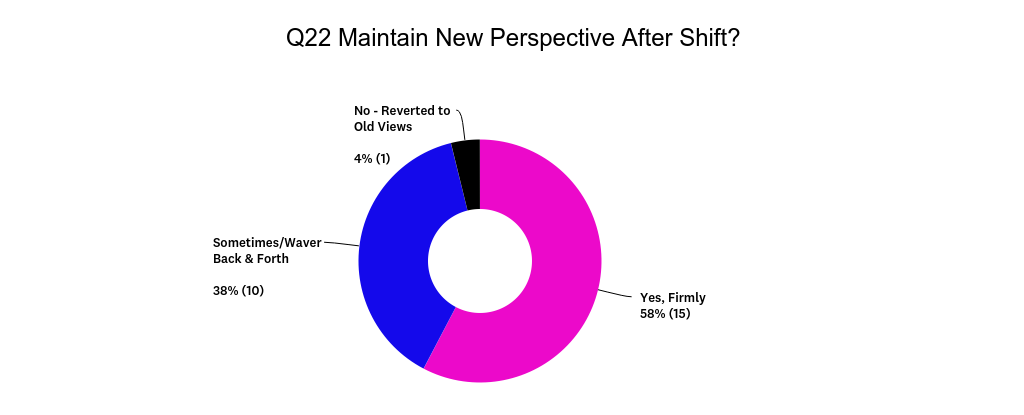
“It’s a 6. No, It’s a 9.” Survey Results.
I recently shared a story about my son’s first experience with perspective and asked people to take a quick survey based on their own experiences. Respondents were asked to describe specific instances where their views on something important to them made a complete reversal, shifted somewhat, or were not acknowledged or respected by another person. Surprisingly, most of the people who took the survey demonstrated flexibility regarding topics that tend to be the most polarizing in our society. These topics were also the ones where the majority of respondents felt their views were not respected: politics and religion. On the other end of the spectrum, race, culture, gender, and disability were topics coming up least as the basis for perspective-changing or disrespect.


I expected to see more shifting on issues of cultural differences, gender and perhaps environmental concerns, given how much we hear about expanding our views in such areas in the news and thru social media. Most interesting was this discrepancy:
In both religion and politics, people exhibited the most reversals or changes in perspectives yet experienced the most rigidity by others.
Basis for Change in Perspective
Out of the 67 people who took the anonymous survey, most were willing to reverse or shift their views on a matter when the change arose from their own, personal experience or the experience of a close friend or relative. News and social media were not nearly as persuasive in actually changing perspectives as experiencing something firsthand or hearing about an experience from someone close to them.


When respondents experienced a complete reversal of views, they were much more likely to maintain their new way of thinking than those whose views only shifted. Given that 73% of the people who completely switched views did so based on personal experience, it’s clear that experiencing something first hand also has a more lasting effect on one’s mindset than other sources of information. Confirmation bias, our tendency to favor information that confirms our existing beliefs, further limits our receptiveness to opposing views from outside sources.


Telling people to think differently doesn’t seem to have much impact, especially if they don’t hear you because they don’t follow you on social media, read your publications, or feel you can identify with them before suggesting they change their views.
Effects of News and Social Media
When news sources and social media hashtags provide content geared towards people with similar views, it’s easy to feel as if we are always divided into camps. Also, people’s views will share some similarities based on the industries in which they work, the communities to which they belong, and the places where they live. Accordingly, we may not encounter or interact with people with different views – on some topics – in our daily lives very often. This may lead to inaccurate ideas of what people holding different or opposing views are actually like: ideas based on news and social media accounts, rather than personal experiences and 1-on-1 interactions.
Feeling Understood Facilitates Flexibility in Perspectives
Feeling less divided is a common goal amongst most of us. In my experience, the best way to feel connected or included in any situation is to feel understood. Feeling understood allows a person to be more open to new information or a different perspective. In the survey, respondents who experienced instances where their views were not acknowledged usually felt that lack of acknowledgment almost equally from a friend, spouse or close family member. This is consistent with the premise that when we experience 1-on-1 interactions with people with opposing views, they tend to be people we already trust. Perhaps because of that trust, most respondents felt varying degrees of hurt by the lack of understanding towards their views, but did not feel differently towards that person.


Practical Suggestions for Lessening the Divide: Inclusion Tips
If you are in a position to share a story or your opinion with a large number of people and hope to shift some views, please consider finding common ground with those who don’t already share your perspective. Likewise, as a consumer of information, try reading publications or watching news/cable news networks with different views, following people on social media who don’t hold the same views as you do, and taking a moment to find something you can identify with when you encounter someone with an opposing view on something of significance to you.
We can all sing our own tunes in beautiful harmony rather than dissonance if we listen and adapt a note here and there, but first we have to believe we are part of the same song.
– Diverse in the City
- Respondents took the survey anonymously thru links on social media or via the online platform, Mechanical Turk.
- Given the small sample size, the insights gleamed from these results are not meant to be conclusive about anything but merely add to the discussions on perspectives and the openness to and tolerance of different views, based on people’s real experiences.
- Most respondents were U.S. residents in their 20s thru 40s living in urban areas and holding at least a bachelors degree. Roughly half of them were female and half male, 64% described themselves as White/Caucasian, 87% described themselves as straight/heterosexual and most referred to experiences occurring within the last 5 years.
- To see specific breakdowns of respondents by demographic information, please click on the link below.
- For the original blogpost inspiring this survey, “It’s a 6. No, It’s a 9.”, please click on the following link:






